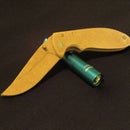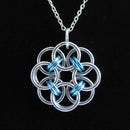Introduction: 3D Modeling an Instructables Ring
Well the great folks over at Instructables have done it again! For the price of just a bit of knowledge they're giving everyone access to super advanced technology like 3D printing. It's always been a dream of mine to get to work with 3D prints, it just hasn't been feasible 'till now. So I decided to give a little tribute to them as a thank you. I think it turned out pretty well :)
And what better use of this than to discreetly show off your love of all things diy?
**Note** Almost all instructions are given in the annotations.
**Note #2** This Instructable focuses primarily on the creation of a CAD model, not necessarily the follow through to production (because that is taken care of on the other side of the country). However, when I get the 3D prints I'll update this page with pictures to show you guys. Sound good? Good! :)
Also, if you want the files pm me or keep bothering me until I figure out how to upload them :P
Step 1: Just Some Info
Autodesk, the maker of a ton of CAD software (and of course the owner of Instructables), has a wonderful program where students and faculty with .edu emails can download free, complete copies of their software on three year licenses. Since that's what I have (specifically Inventor Professional 2012), that's what I'll focus on.
I haven't used 123D or OpenSCAD enough to tell you if they'll be able to produce the same result, but this was entirely created with fairly basic functions so hopefully all the operations are compatible. Good luck! And if you get other programs to work, leave a comment and I'll update this section :)
Step 2: Sketch 1 (the Basic Outline)
After opening the program, this is where you create the overall shape of the ring (when viewed through the center).
Step 3: Extrusion and Revolution 1 (drawing Out and Shaping the Form)
Here's where you start to see it actually take shape.
Step 4: Trimming the Fat (refining the Form)
Getting the right profile.
Step 5: Softening the Edges
Don't want any sharp bits, now do we?
Step 6: Prepping the Emblem Surface (anything Look Familiar?)
:D
Step 7: First Layer
Alright, now that we've got the pattern down we need to actually create the 3D bit.
Step 8: Second and Third Layers
Everything's extruded and rounded off. Looks good!
Step 9: Making the Insert
With Instructables' snazzy dual material printers, the rest of this 'ible is actually possible to make. What we're going to do is create another piece that will fit perfectly in the 1/64" cutout at the top. The insert material will be perfectly flush with the base material, that's why we didn't fillet the first layer.
Step 10: Assembly Time!
As the title suggests, this is where everything comes together!
Step 11: Just Playing Around :)
What I love about computers is how easy it is to change and experiment with components. In this case, playing around with material selection!













